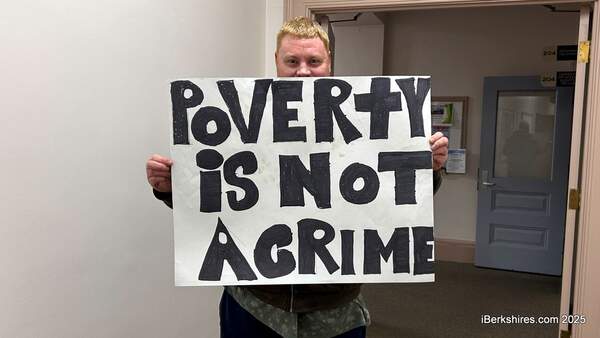
WMECo Solar Array Prompts Interest in Business Park
 Peter Clarke, president of WMECo, speaks about the $10 million, 1.8-MW project in Pittsfield's William Stanley Business Park. |
The crop may also have business blooming at the long-gestating William Stanley Business Park, William M. Hines Sr. said Monday as partners, stakeholders and local officials gathered to celebrate the start of construction on the 1.8-megawatt photovoltaic system.
"The publicity about the pending solar project has already generated additional interest in businesses who are inquiring about the Williams Stanley Business Park," said the head of the Pittsfield Economic Development Authority. "Especially green and eco-enterprises."
The array is the first and largest of its kind in New England, but the $10 million project is just the first solar facility being planned by WMECo. Pittsfield was chosen as the first site after looking at a number of other so-called "Gateway Cities" flush with languishing industrial lands and brownfields.
Pittsfield's "very progressive leadership was what really allowed us to do the deal quickly and get the project done," said WMECo President and Chief Executive Officer Peter Clarke as the heavy machinery could be heard in the background clearing land on the south side of the utility's substation on Silver Lake Boulevard.
The early afternoon sun was high in the sky (WMECo even brought dark shades for attendees) but Hines described the city, the business park and the electric utility as "a true coming together of a perfect storm for this project."
The 6,500-panel installation will be built on eight acres; six owned by WMECo and two by PEDA. In between them is the substation that will allow energy to be distributed into the system.
 The empty lot next to the WMECo substation is being prepped for the panels' installation. |
"We know the technology will work, we know it's proven," he said. "We will measure the economics but what we believe ... is that developing larger arrays will bring the economies of scale into play so the fixed costs go down as you spread it over more units."
"We know it's a repeatable progam and we'll demonstrate that this site makes a lot of sense."
WMECo is investing more than $18 million in energy efficiency this year, said Clarke. "We are working with consumers to conserve first and to develop indigenous renewable like solar, maybe someday eventually wind power, to be able to replace foreign oil and coal with renewable energy."
Gov. Deval Patrick has set a goal of 250 MW of solar by 2017; under the Green Communities Act, utilities can produce up to 50 MW. WMECo is authorized for 6 MW and its Pittsfield installation will make up a nearly a third of that.
That project is expected to generate 70 construction jobs and bring in about $150,000 in property taxes for the city once it's completed this fall. The contractor is American Capital Energy of Chelmsford. For the beleaguered PEDA, it finally gets a tenant in the park — one that's sparking serious interest in the former GE site.
 William M. Hines Jr., being interviewed by our media partner Berkshire News Network, said the array is sparking an interest in the business park. |
Mayor James M. Ruberto said the array and the work done between so many entities — from the city, to the state, to GE, PEDA, WMECo and Massachusetts Electric, and more — showed that together they could "forge something truly dramatic."
"I think it's going to be a great addition to the park as people come in and look at prospective site for their business to see this progressive solar energy that's out here," said Clarke. "And I think it really puts Pittsfield on the map as a progressive city."
















